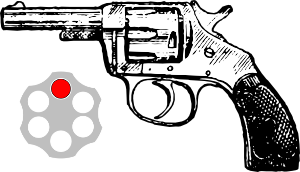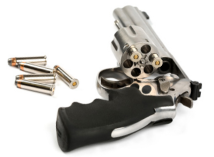| Most people are familiar with the game of Russian Roulette.However, just in case, here’s a recap of the vanilla variant: You take a revolver which has six empty chambers, insert a single cartridge, and then give the cylinder a good spin. When the spindle stops (presumably in a random position), you pull the trigger.CLICK! If the chamber was empty you live. If the round stopped in the firing position, you die. |  |
However, just in case, here’s a recap of the vanilla variant: You take a revolver which has six empty chambers, insert a single cartridge, and then give the cylinder a good spin. When the spindle stops (presumably in a random position), you pull the trigger.
| |The probability of surviving is an, easy to calculate, and very unhealthy, 83.3% (5/6).You have a one in six chance that the live round stopped in the firing position. It’s a stupid game, never play it!|
|The probability of surviving is an, easy to calculate, and very unhealthy, 83.3% (5/6).You have a one in six chance that the live round stopped in the firing position. It’s a stupid game, never play it!|
You have a one in six chance that the live round stopped in the firing position. It’s a stupid game, never play it!
Interview Question
According to the internet (so it has to be true), there is a variant of the Russian Roulette problem that is commonly asked as an interview question. It goes like this:
“Let’s play a game of Russian Roulette. You are tied to a chair. Here’s a gun, six chambers, all empty. Now watch me as I put two bullets in the gun into adjacent chambers. I close the cylinder and spin it. I put the gun to your head and pull the trigger. Click. You’re still alive. Lucky you! Now, before we discuss your résumé, I’m going to pull the trigger one more time. Which would you prefer, that I spin the cylinder first or that I just pull the trigger?”
 |
Putting aside, for the moment, that these ‘puzzle style’ interview question are very poor at giving signal about the aptitude of a candidate (these type of questions more accurately test if a candidate has heard, and can recall, the puzzle solution, instead of being able to solve it under presure), what is the correct answer to this puzzle?*(Oh, and missing from this interview question description, which I copied verbatim from the internet, is the assumption that you know that a revolver cylinder advances one position after each pull of the trigger).The correct answer is that you should ask the interviewer to pull the trigger again, without spinning. We’ll examine the math in detail below, but hopefully you can see this is correct with a short amount of thinking: |
(Oh, and missing from this interview question description, which I copied verbatim from the internet, is the assumption that you know that a revolver cylinder advances one position after each pull of the trigger).
-
If the cylinder is spun again, the second pull will be exactly the same risk as the first pull. There are two rounds, and six locations. There is a one in three chance that you will die. This probability does not change with any number of spins. There is a 66.7% chance (4/6) that you will live.
-
If the cylinder is not spun, the key to calculating the odds is the clue that the rounds are located in adjacent chambers. This means that there are two rounds next to each other, followed by four blank spaces. We heard a click on the first pull, which means we are somewhere in the run of these four blank locations. Of these four spaces, only one of them is followed by a round. There is a one chance in four that we are at this bad location, and it means that there is a 3 in 4 chance that the chamber to come is empty. By not spinning again there is a 75% chance we will live.
75% > 66.7% so we should request the trigger is pulled without a re-spin.
(If we survive this second pull, and the devious torturer says he wants to pull the trigger a third time, well, at that point it makes no difference if the cylinder is spun, or the trigger is pulled one more time).
*If I ever went to an interview and was asked this question, I’d probably say that I’d only answer the question if the interviewer could give me, in return, the correct answer about what to do if the two rounds were placed in random (not adjacent) positions. If the interviewer could not answer, it’s clear that they are just asking cookie-cut questions that they already know the solution to. I’d conclude, therefore, that I’d probably no want to work for them. If they could answer, we’d have mutual respect, and I’d probably really enjoy talking and working with this person. An interview should be a symbiotic experience: It’s as much about the interviewer selling themselves to the candidate as it is the candidate selling him/her-self to the interviewer (IMHO).
Two Random Rounds

Let’s change the problem. Rather than restricting the two rounds to be in adjacent chambers, let’s calculate what would happen if they were placed in random locations. There are 6 choose 2 ways (fifteen) that two rounds can be placed into the cylinders. Without loss of generality, here they are:
| |- There are six possible ways the cartridges can be loaded adjacent.- There are six possible ways the cartridges can be loaded one apart.- There are three possible ways the cartridges can be loaded opposite.|
|- There are six possible ways the cartridges can be loaded adjacent.- There are six possible ways the cartridges can be loaded one apart.- There are three possible ways the cartridges can be loaded opposite.|
We already know that, in the adjacent case, there is a 3/4 chance that the chamber following an empty chamber is also empty. The adjacent condition occurs 6/15. We multiply these probabilities together.
We next add the similar conditional probabilities for the six one-apart cases (where two out of the four empty cells has a following empty chamber), and finally for the three opposite cases (again where two out of the four empty cells has a following emoty chamber).

There is a 60% chance (3/5) we will survive a second trigger pull with two rounds in arbitrary locations.
This is slightly lower than the 66.7% survival chance that will happen with a re-spin, so if the two rounds are loaded randomly it’s better to ask for a re-spin.
Three Random Rounds

Let’s keep going. What are our chances if there are three randomly located rounds?
There are 6 choose 3 ways (twenty) ways that three cartridges can be loaded into the cylinder.
-
There are six possible ways that the cartridges can be loaded all adjacent.
-
There are twelve possible ways the cartridges can be loaded with one and two space gaps.
-
There are two possible ways the cartridges can be loaded alternating.
In the first case, there are two empty cells (out of three), in which the following cell is also empty. In the middle case, only one case where the following cell is also empty. If the rounds are alternating, there is no way a second trigger can be pulled safely!

There is a 40% chance (2/5) we will survive a single trigger pull with three rounds in arbitrary locations.
There is a 50% chance of survival with a re-spin, so again, it is better to ask for the re-spin.
Four Random Rounds

| Let’s keep going. What are our chances if there are four randomly located rounds?There are 6 choose 4 ways (fifteen) ways that four cartridges can be loaded into the cylinder. This is, actually, just the inverse (complement) of the two cartridge case arrangement; Instead of putting in two cartridges at random, we are starting with a full cylinder, and pulling out two random ones.Only when there are four cartridges in a row can there be two adjacent gaps. And only one of these will allow a successful second pull. |  |
There are 6 choose 4 ways (fifteen) ways that four cartridges can be loaded into the cylinder. This is, actually, just the inverse (complement) of the two cartridge case arrangement; Instead of putting in two cartridges at random, we are starting with a full cylinder, and pulling out two random ones.

There is a 20% chance of surviving a second trigger pull without a re-spin.
There is a 33.3% chance with a re-spin.
Five Random Rounds

If you are lucky enough to hear a first click, you’ll not hear another if you pull again. It’s not possible to pull a second time without a re-spin. Cross your fingers and ask for a re-spin.
Six Random Rounds

There are no empty chambers. All you can do is pray for a double missfire!
You can find a complete list of all the articles here. Click here to receive email alerts on new articles.
Click here to receive email alerts on new articles.